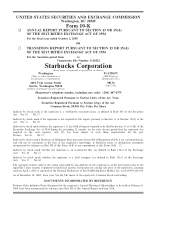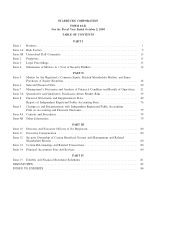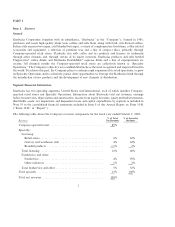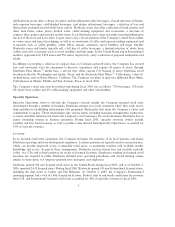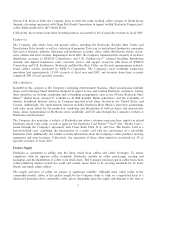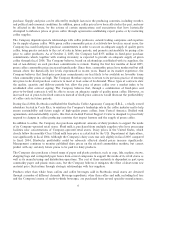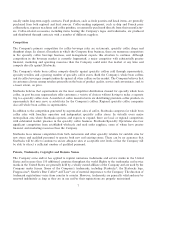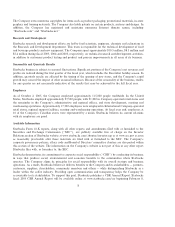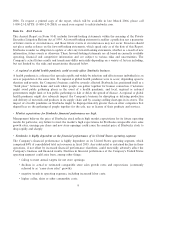Starbucks 2005 Annual Report Download - page 8
Download and view the complete annual report
Please find page 8 of the 2005 Starbucks annual report below. You can navigate through the pages in the report by either clicking on the pages listed below, or by using the keyword search tool below to find specific information within the annual report.purchase. Supply and price can be affected by multiple factors in the producing countries, including weather,
and political and economic conditions. In addition, green coffee prices have been affected in the past, and may
be affected in the future, by the actions of certain organizations and associations that have historically
attempted to influence prices of green coffee through agreements establishing export quotas or by restricting
coffee supplies.
The Company depends upon its relationships with coffee producers, outside trading companies and exporters
for its supply of green coffee. With green coffee commodity prices at relatively low levels in recent years, the
Company has used fixed-price purchase commitments in order to secure an adequate supply of quality green
coffee, bring greater certainty to the cost of sales in future periods, and promote sustainability by paying a fair
price to coffee producers. As of October 2, 2005, the Company had $375 million in fixed-price purchase
commitments which, together with existing inventory, is expected to provide an adequate supply of green
coffee through fiscal 2006. The Company believes, based on relationships established with its suppliers, the
risk of non-delivery on such purchase commitments is remote. During the first few months of fiscal 2005,
green coffee commodity prices increased significantly. Since then, commodity prices have moderated but still
remain above the historically low levels experienced in recent years. Based on its market experience, the
Company believes that fixed-price purchase commitments are less likely to be available on favorable terms
when commodity prices are high. The Company therefore expects to return to its previous practice of entering
into price-to-be-fixed purchase contracts to meet at least some of its demand. These types of contracts state
the quality, quantity and delivery periods but allow the price of green coffee over a market index to be
established after contract signing. The Company believes that, through a combination of fixed-price and
price-to-be-fixed contracts it will be able to secure an adequate supply of quality green coffee. However, an
increased use of price-to-be-fixed contracts instead of fixed-price contracts would decrease the predictability
of coffee costs in future periods.
During fiscal 2004, Starbucks established the Starbucks Coffee Agronomy Company S.R.L., a wholly owned
subsidiary located in Costa Rica, to reinforce the Company's leadership role in the coffee industry and to help
ensure sustainability and future supply of high-quality green coffees from Central America. Staffed with
agronomists and sustainability experts, this first-of-its-kind Farmer Support Center is designed to proactively
respond to changes in coffee producing countries that impact farmers and the supply of green coffee.
In addition to coffee, the Company also purchases significant amounts of dairy products to support the needs
of its Company-operated retail stores. Fluid milk is purchased from multiple suppliers who have processing
facilities near concentrations of Company-operated retail stores. Dairy prices in the United States, which
closely follow the monthly Class I fluid milk base price as calculated by the U.S. Department of Agriculture,
rose significantly in fiscal 2004. Although the Company's dairy costs rose only slightly in fiscal 2005 compared
to fiscal 2004, Starbucks profitability could be adversely affected should prices increase significantly.
Management continues to monitor published dairy prices on the related commodities markets, but cannot
predict with any certainty future prices to be paid for dairy products.
The Company also purchases a broad range of paper and plastic products, such as cups, lids, napkins, straws,
shopping bags and corrugated paper boxes from several companies to support the needs of its retail stores as
well as its manufacturing and distribution operations. The cost of these materials is dependent in part upon
commodity paper and plastic resin costs, but the Company believes it mitigates the effect of short-term raw
material price fluctuations through strategic relationships with key suppliers.
Products other than whole bean coffees and coffee beverages sold in Starbucks retail stores are obtained
through a number of different channels. Beverage ingredients, other than coffee and milk, including leaf teas
and the Company's menu of ready-to-drink beverages, are purchased from several specialty manufacturers,
6

